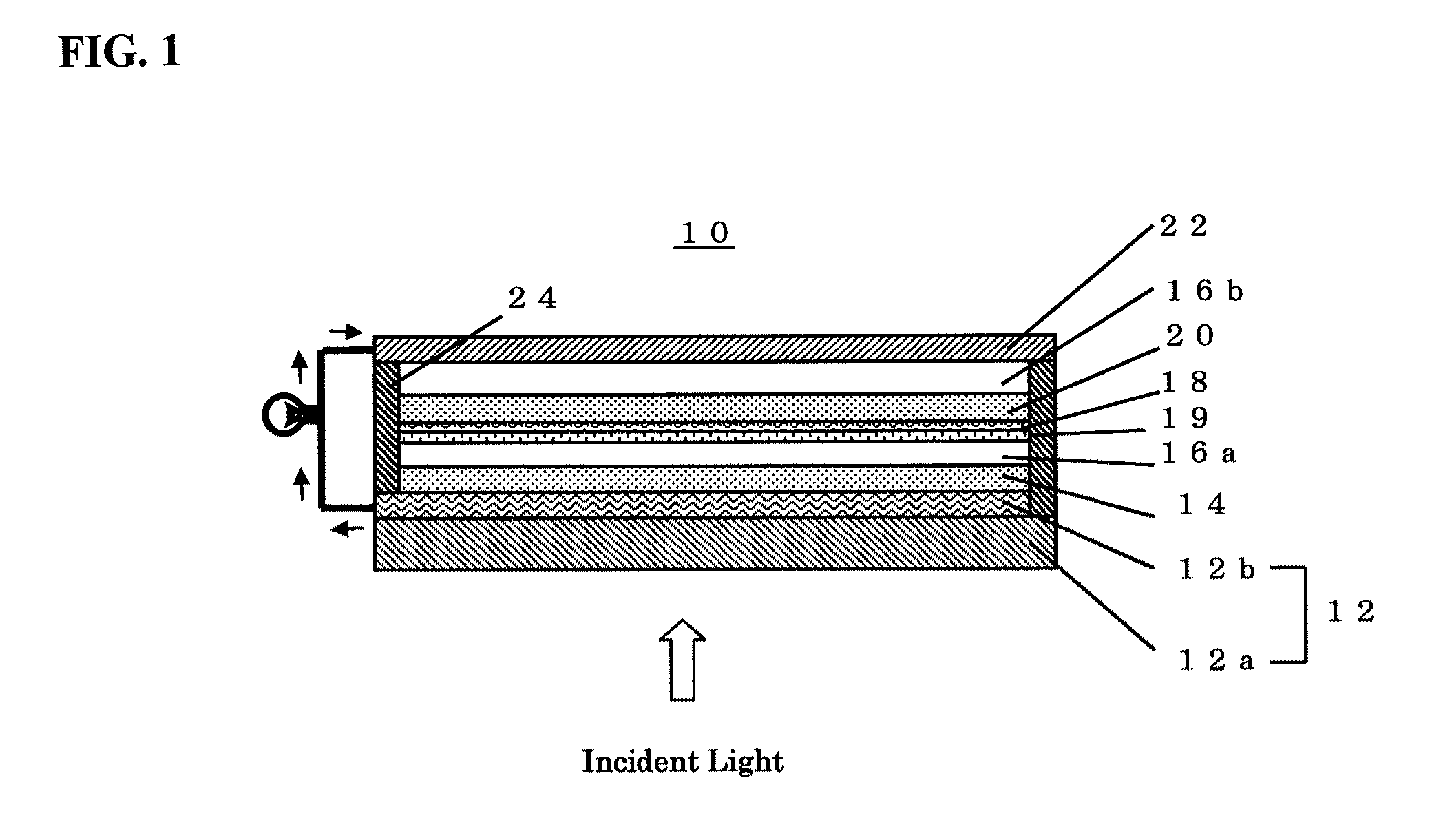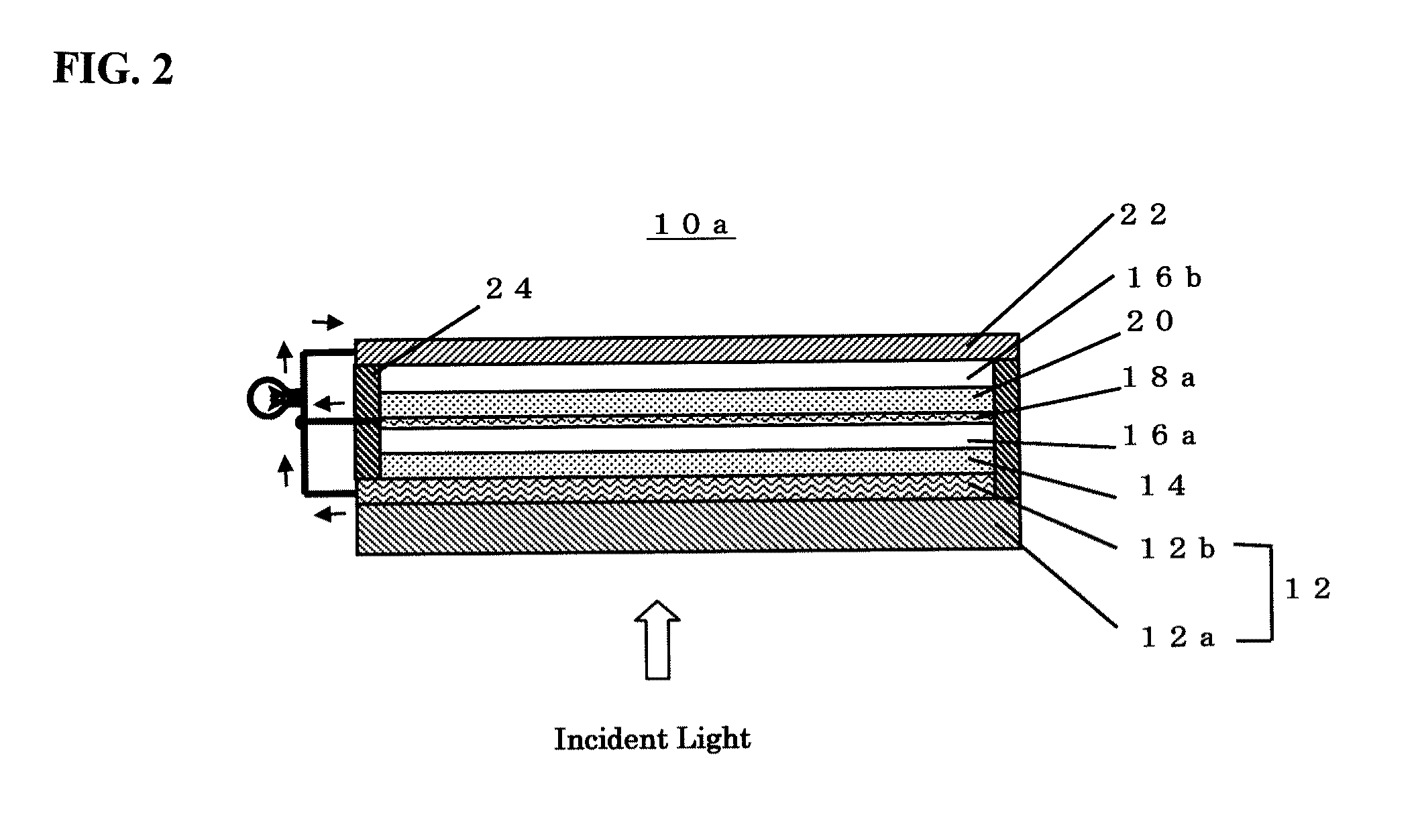Dye-sensitized solar cell
a solar cell, dye-sensitive technology, applied in the manufacture of final products, electrochemical generators, pv power plants, etc., can solve the problems of increasing and achieve the effect of reducing the manufacturing cost of the cell and superior optical absorption efficiency
- Summary
- Abstract
- Description
- Claims
- Application Information
AI Technical Summary
Benefits of technology
Problems solved by technology
Method used
Image
Examples
example 1
Practical Example 1
[0068]An FTO film (surface resistance: 10 Ω / sq) was formed on a transparent glass substrate, and titania paste was coated on the FTO film and dried at 450° C. for 30 minutes, thereby fabricating a 2 μm-thick porous titania layer. The above-described first dye (Dye 2) was adsorbed to this porous titania layer to fabricate a first electrode. On the other hand, titanium was film-formed by sputtering on a stainless mesh substrate (25 μm in thickness) including a mesh 20 μm in diameter. Thereafter, titanium was further film-formed using arc plasma while introducing oxygen, thereby fabricating a surface-protected stainless mesh structure. Titania paste was coated on the mesh structure and dried at 450° C. for 30 minutes, thereby fabricating a 2 μm-thick porous titania layer. After platinum was sputtered on a surface of the mesh structure on the side thereof on which the porous titania layer was not provided, the above-described second dye (Dye 2) was adsorbed to this ti...
example 2
Practical Example 2
[0070]An FTO film (surface resistance: 10 / sq) was formed on a transparent glass substrate, and titania paste was coated on the FTO film and dried at 450° C. for 30 minutes, thereby fabricating a 2 μm-thick porous titania layer. The first dye was adsorbed to this titania layer to fabricate a first electrode. On the other hand, titanium was film-formed by sputtering on a stainless mesh substrate (25 μm in thickness) including a mesh 20 μm in diameter. Thereafter, titanium was further film-formed using arc plasma while introducing oxygen, thereby fabricating a surface-protected stainless mesh structure. Titania paste was coated on the mesh structure and dried at 450° C. for 30 minutes, thereby fabricating a 2 μm-thick porous titania layer. The second dye was adsorbed to this titania layer, thereby fabricating a second electrode. For an electrolytic solution, a gel electrolytic solution prepared by impregnating a porous PTFE (polytetrafluoroethylene) film (50 μm in t...
reference example 1
[0072]Titania paste was coated on a stainless mesh substrate (25 μm in thickness) including a mesh 20μm in diameter and dried at 450° C. for 30 minutes, thereby fabricating a porous titania layer. This coating and drying of the titania paste was repeated until the thickness of the porous titania layer reached a predetermined thickness, thereby finally fabricating a 10 μm-thick porous titania layer. A dye (D-149 made by Mitsubishi Paper Mills Limited) having the chemical structure of the dye 3 shown in FIG. 6 was adsorbed to this titania layer to fabricate a second electrode. For an electrolytic solution, a gel electrolytic solution prepared by impregnating a porous PTFE (polytetrafluoroethylene) film (35 μm in thickness and 71% in porosity) with an electrolytic solution was used. A counter electrode was fabricated by sputtering platinum on titanium. The titania layer side of the porous titania layer fabricated as described above and the platinum side of the counter electrode were la...
PUM
 Login to View More
Login to View More Abstract
Description
Claims
Application Information
 Login to View More
Login to View More - R&D
- Intellectual Property
- Life Sciences
- Materials
- Tech Scout
- Unparalleled Data Quality
- Higher Quality Content
- 60% Fewer Hallucinations
Browse by: Latest US Patents, China's latest patents, Technical Efficacy Thesaurus, Application Domain, Technology Topic, Popular Technical Reports.
© 2025 PatSnap. All rights reserved.Legal|Privacy policy|Modern Slavery Act Transparency Statement|Sitemap|About US| Contact US: help@patsnap.com



